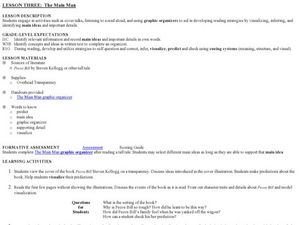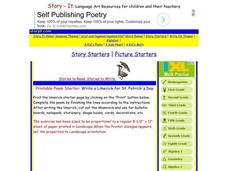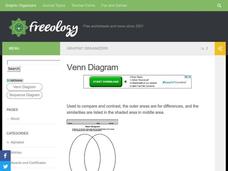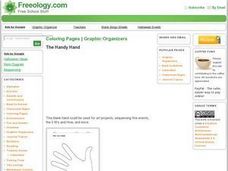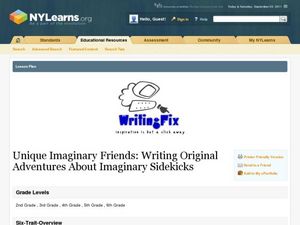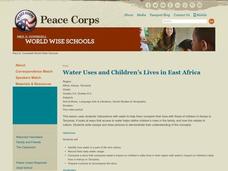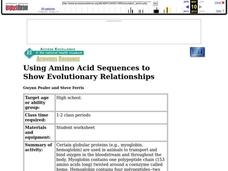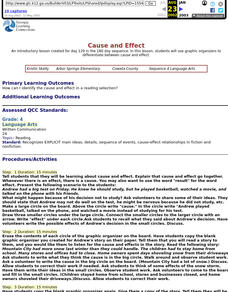Curated OER
Just the Facts, Ma'am
Learners use tables of content, chapter titles, and key words as a strategy for organizing non-fiction information. They write a paragraph with a partner using information from a graphic organizer.
Curated OER
Snapshots of a Short Story
First graders will be creating and filling in a graphic organizer using Kidspiration, as a pre-writing activity for their short story piece. They then use their graphic organizers to write their entire short story. Once written, the...
Curated OER
The Main Man
Students explore visualizing stories by completing a graphic organizer. In this reading strategy lesson, students read the story Pecos Bill by Steven Kellog and identify the setting, main characters and their interpretations. Students...
Curated OER
Printable Poem Starter: Write a Limerick for St. Patrick's Day
This shamrock-shaped graphic organizer helps students set up a limerick based on a few sample lines. Students are prompted on which lines should rhyme, and how many syllables each line should have. Once they are finished, the shamrocks...
Curated OER
Printable Poem Starter: Write a Limerick for St. Patrick's Day
This shamrock-shaped graphic organizer helps students set up a limerick based on a few sample lines. Students are prompted on which lines should rhyme, and how many syllables each line should have. Once they are finished, the shamrocks...
Curated OER
Venn Diagram
In this Venn diagram worksheet, students use a blank graphic organizer to list the differing characteristics of two issues in the outer circles. Students list the shared characteristics in the middle area.
Curated OER
America's Civil Rights Movement, Cubing
Learners explore cubing as a graphic organizer to better explain the key concepts of the Civil Rights Movement and take positions on key concepts regarding the Movement.
Curated OER
Give 'em a Hand
In this graphic organizer worksheet, students use the shape of the hand to find the who, what, where, when, and why for a text. Students write their answers in the fingers.
Curated OER
Facts That Add to 5
In this addition worksheet, students write addition sentences that equal 5. Students use the 5 spaces surrounding the number four in the center of the graphic organizer and create equations with 5 as the sum.
Curated OER
Making Sense in Social Studies
In this graphic organizer worksheet, students respond to 2 questions by writing in the thesis and proof as well as completing a summary paragraph.
Curated OER
Describe Your Favorite City and Country
In this ESL activity worksheet, students describe their favorite city and country as they complete the graphic organizer with 16 adjectives.
Curated OER
Describe Your Favorite Country and Its Sights
In this ESL activity worksheet, students describe their favorite country and its sights as they complete the graphic organizer with 16 adjectives.
Curated OER
Writing Original Adventures About Imaginary Sidekicks
Young scholars explore storytelling by conceptualizing a story with classmates. In this publishing lesson, students identify the idea development process and discuss word choice when writing a story. Young scholars utilize a graphic...
Virginia Department of Education
Translate and Evaluate
Hopefully nothing gets lost in translation. Pupils translate between verbal phrases and algebraic expressions. They then use candy to determine what values to substitute into the expressions.
Curated OER
How Do Scientists Classify Organisms?
In this classification worksheet, students write in examples of the 6 kingdoms: archaebacteria, eubacteria, protists, fungi, plants, and animals. This worksheet is a graphic organizer.
Curated OER
How Do Animals Use Their Parts?
In this animal adaptations worksheet, students complete a graphic organizer by filling in the body part that completes the animal adaptation statement. This worksheet has 6 examples to fill in.
Curated OER
How Do We Use Water?
In this water use worksheet, students brainstorm different ways people use water and then complete 3 fill in the blank statements about how people can keep water clean. This worksheet is a graphic organizer.
Curated OER
Water Uses and Children's Lives in East Africa
Learners identify how water use is part of life and culture. Students record their daily water usage and compare results with classmates. Learners complete the graphic organizer on water and children. Students compose an essay, which...
Curated OER
Rocks and Soils Graphic Organizer
In this earth science worksheet, students complete a chart by describing different types of rocks and soils. They search for the specified rocks in their world and describe them using the words in a word bank at the bottom of the page.
Curated OER
Using Amino Acid Sequences to Show Evolutionary Relationships
Junior biologists compare the amino acid sequences from fragments of five different globin molecules. They count the letter differences between each species pair. They construct a graphic representation of the evolutionary relationships...
Polk Bros Foundation
I Can Identify and Support the Main Idea in Non-Ficiton
Analyze a historical or scientific informational text by determining the main idea and supporting details. This graphic organizer allows pupils to write down the main idea and four details.
Curated OER
Using Amino Acid Sequences to Show Evolutionary Relationships
Compare protein fragments, count amino acids, and use the information to explore common ancestry. The resource mentions a student worksheet, however, a separate printable worksheet is not provided. The exercises are written into the...
Curated OER
Cause and Effect
Fourth graders use graphic organizers to differentiate between cause and effect. They read a story independently and write the cause and effects in the graphic organizer.
Curated OER
Trumpet of the Swan Graphic Organizer
In this literature worksheet, students use this graphic organizer to list details about the book Trumpet of the Swan. The title is in the center of the circle and there are 8 lines coming out of it which students can use to write details.




